4K TV may be the Next Big Thing. Eventually. Or maybe not.

Y'see, I never got the whole 3D thing – and this isn't going to be some kind of Kermodian rant about lowered light and contrast levels, effects added in during post-production or how the 3D doesn't add anything to the movie experience, but just ongoing mystification at why anyone would want to put glasses on in order to watch TVs in the cinema, let alone at home.
I've seen a lot of 3D demonstrations, both here and on visits to TV manufacturers in Japan, China and Korea; I've watched with active glasses, passive glasses and no glasses at all; and I've seen everything from Avatar – many, many times – to specially-shot demonstrations of F1 racing cars, Japanese animation and Korean pop sensations.
And I still don't get it.
Neither, it seems, do many home viewers – at least not once the novelty has worn off. Even gamers – once seen as the obvious target for things popping out of the screen at them – appear to have greeted 3D with initial enthusiasm and the something of a yawn.
In a recent interview with Eurogamer during the Japanese launch of the new versions of the PS3, Sony Computer Entertainment VP and MD for the UK and Ireland said that 'It's fair to say consumers have decided [3D]'s not hugely important at this time.'
He went on 'Whether you look at movies or games, wearing the glasses and consuming 3D in that way in the home isn't hugely popular. That's just a fact. I haven't read detailed research on it, but the glasses will certainly be a big part of the hassle factor.
'I also think there's a bit of a difference between the highly focused viewing and the more casual viewing. In the home people tune in and tune out a bit, and doing that with glasses on and glancing at your tablet or pausing for a bit, compared to the cinema experience which is a solely focused experience, you know there is a difference emerging there.'
Get the What Hi-Fi? Newsletter
The latest hi-fi, home cinema and tech news, reviews, buying advice and deals, direct to your inbox.
3D running out of steam
Trouble is, even in the 'highly focused viewing' situation of the cinema, 3D is showing signs of running out of steam. A report earlier this year pointed out that in 2011, despite there being a record 47 films released in 3D in the UK, box-office takings for 3D screenings fell 3% to £230m, and 3D's total share of the billion-pound-plus total UK box-office reduced 17% year-on-year.
Average box office take per 3D movie? £8.5m in 2010, £4.9m in 2011, despite – or maybe due to – ticket prices of up to a third more for 3D screenings over 2D showings. Even the much-vaunted final part of the Harry Potter series didn't help 3D's cause much.

No wonder there are only 33 movies being released here in 3D this year, down a third on 2011.
And then there's the growing trend toward watching movies at home: just as the arrival of VHS, then DVD and Blu-ray, was heralded as being the end of cinema, so now the ever-earlier release of content on streaming services – and indications that the first-run-to-home-viewing delay is going to get even shorter – means more films are being seen for the first time in the home.
Not least, I suspect, because a family visit to the cinema is just so damn expensive these days: book for a couple of adults and two kids, and you could be paying £60 or more for your tickets; factor in all the usual cinema comestibles and the cost of transport, and you could easily be into £100 or so for a couple of hours of entertainment.
No wonder Netflix, Lovefilm and the rest are just the start: as I reported from my visit to Datasat a month or two back, there's an ambition for well-heeled home cinema fans to have access to films in their homes the same day they're released theatrically. And what's available at the cutting edge of technology has a habit of trickling down to us mere mortals in the fulness of time.
So, 3D has failed to do the trick – the trick in question being getting us to pay more, whether it's for cinema tickets or 3D-capable TVs. After all, there may be a lot of TVs out there with 3D available, but most of them are no longer the premium-priced sets the TV manufacturers hoped we'd buy, thus restoring the profits of their display businesses.
TV prices have tumbled, 3D has become commoditised, and in fact I'd be willing to suggest that many buyers of sets able to display SwimmyVision™ never actually use that functionality.
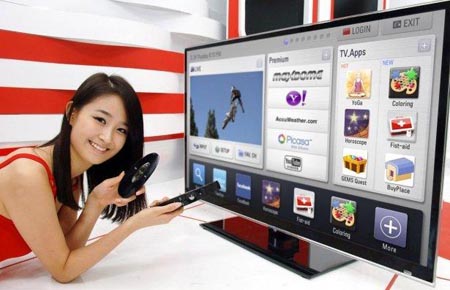
So what is the big sell these days? Smart TV? Hmm, maybe – but again it's not a premium feature anymore – just about every TV worth its salt has it, and those that don't can be upgraded with everything from a Blu-ray player with 'smart' internet capability to a range of inexpensive add-on boxes.
No, the TV-manufacturing industry has moved on. Again.
And the next Next Big Thing is, we're told, going to be 4K TVs.
Or 8K TVs. Well, anyway, big, expensive TVs offering higher resolution and even larger screen sizes, ready to make the most of all that super-whizzy content that'll soon be streaming into our homes, straining every fibre of our fibre-optic connections in the effort to deliver ever greater data throughput.
For the TV manufacturers, big is good, and unique features are good - basically because both mean more expensive, which is very, very good for the bottom line.
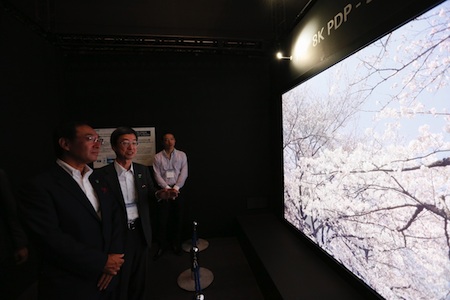
Hence the arrival of technology showcase models such as the Panasonic 145in 8K display (above), shown at the IFA show in September and last week at the CEATEC exhibition in Japan: offering eight times the resolution of current HD TVs – hence the 8K description –, it's Panasonic's marker against the 4K (four times HD resolution) sets shown by the likes of LG, Samsung, Sony and Toshiba.

Just to clarify, a current 1080p HDTV picture has a resolution of 1920x1080 pixels, or a total of 2,073,600 pixels making up each frame, and 4K 3840x2160 pixels, for a total of 8,294,400 pixels.
That's four times the resolution of standard HD.
8K, with 7680x4320 pixels, has 33,177,600 pixels in total: four times that of 4K, or 16 times the current HD standard.
You may recall we had the 84in Sony 4K TV onsite last week: arriving in a box looking like it should be wheeled into middle distance and then pushed into an aisle at the end of Raiders of the Lost Ark, the KD-84X9005 is due to go on sale in December at £25,000.
However, 4K isn't all about huge, silly-money sets: Panasonic has (almost unfathomably) been showing a 20in 4K display, an exercise in serious pixel-packing, while Sony boss Kaz Hirai told reporters at CEATEC last week that the KD-84X9005 'is not the only 4K product that Sony will bring out.
'We have plans for other 4K models as well, but we wanted to start out with a flagship model to make sure we sent a strong message about our commitment in 4K.'
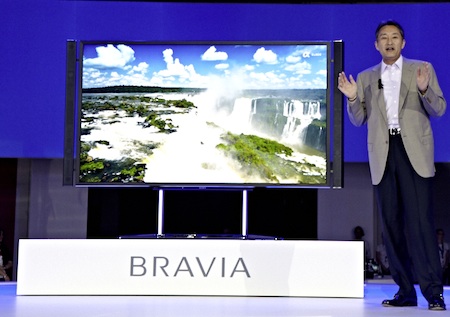
'The pricing right now is obviously not a mass-market product,' Hirai (above) went on, 'It's more of our message to the market about our leadership position we'd like to take in the 4K market as well as making sure that we have a flagship product to really get 4K taking off in the right way.'
However, 4K could have a struggle to establish itself in the market, according to analyst IHS iSuppli: it expects just 4000 sets to be sold this year, even though Chinese brands such as Hisense and Konka are expected to join the fray soon, rising to 2.1m units worldwide, but not until 2017.
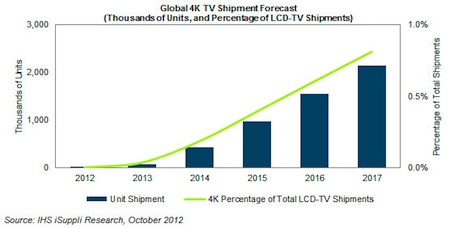
Even then, it expects 4K to account for just 0.8% of the global TV market, noting that the technology is best suited to large screen TVs, and that only about 1.5% of the market is taken up by sets of 60in or larger.
IHS director of TV systems and technology research Tom Morrod says that 'a very limited amount of content is available at the 4K resolution. Furthermore, for most people, the 1,080p resolution is good enough. Because of these factors, combined with the massive price tags, the market for 4K sets during the next few years will be limited to very wealthy consumers or to commercial uses.'
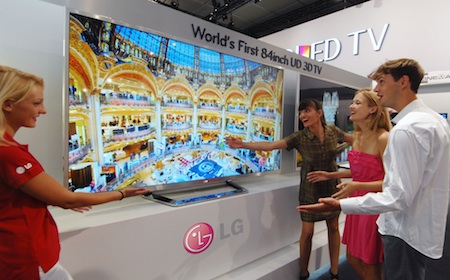
The damning summary from IHS? 'Neither consumers nor television brands will have the interest required to make the 4K LCD-TV market successful.'
Hmm - so…? Well, IHS suggests that 'leading television brands may be viewing 4K merely as a transitional product' while they struggle to get their act together over the Next Big Thing But One – AMOLED TVs of the kind some of the major players showed at CES at the beginning of this year, and which the Korean rivals, LG and Samsung, are already selling in limited numbers back home.
Morrod's view? '4K sets can fill the gap at the high-end of television brands’ product lines until the arrival of the next-generation active-matrix organic light-emitting diode televisions (AMOLED TVs).
'Japanese brands are offering 4K product because they need to have a competitive alternative to the AMOLED TVs being sold by their rivals in South Korea.
'Meanwhile, the South Korean companies are having difficulties producing AMOLED panels, saying they will need two more years to achieve competitive volume and pricing. Therefore, the Korean brands are offering 4K sets as a transitional step until their AMOLED televisions are more widely available.'
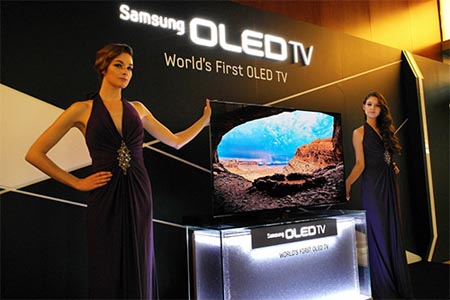
Of course, when we finally do get commercially-viable AMOLED sets, they're likely to be 4K. Or 8K. Or who knows how many K.
But just as 3D was tried, and is now being quietly consigned to being just another feature, and smart functionality is now so ubiquitous as to hardly merit mention, so the big-screen 4K LCD TV could be just another stop-gap while the global consumer electronics industry struggles to find some way, any way, to start making money selling TVs again.
Anyone remember big-screen rear-projection tellies? Anyone still got one? No, thought not…
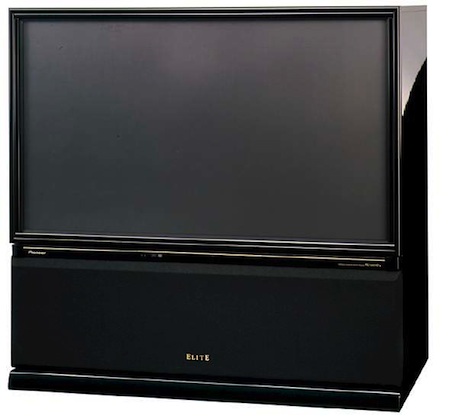
Andrew has written about audio and video products for the past 20+ years, and been a consumer journalist for more than 30 years, starting his career on camera magazines. Andrew has contributed to titles including What Hi-Fi?, Gramophone, Jazzwise and Hi-Fi Critic, Hi-Fi News & Record Review and Hi-Fi Choice. I’ve also written for a number of non-specialist and overseas magazines.
